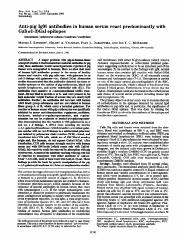Please use this identifier to cite or link to this item:
https://ahro.austin.org.au/austinjspui/handle/1/13017| Title: | Anti-pig IgM antibodies in human serum react predominantly with Gal(alpha 1-3)Gal epitopes. | Austin Authors: | Sandrin, Mauro S ;Vaughan, Hilary A;Dabkowski, P L;McKenzie, Ian F C | Affiliation: | Molecular Immunogenetics Laboratory, Austin Research Institute, Austin Hospital, Heidelberg, Victoria, Australia | Issue Date: | 1-Dec-1993 | Publication information: | Proceedings of the National Academy of Sciences of the United States of America; 90(23): 11391-5 | Abstract: | A major problem with pig-to-human-tissue xenograft studies is that humans have natural antibodies to pig cells; these antibodies would cause hyperacute rejection if pig tissues were xenografted to humans. Here we show that most of human IgM antibodies present in the serum of healthy donors and reactive with pig cells react with galactose in an (alpha 1-3) linkage with galactose--i.e., Gal(alpha 1-3)Gal. Absorption studies demonstrated that the antibodies detected the same or similar epitopes on the surface of pig erythrocytes, blood and splenic lymphocytes, and aortic endothelial cells (EC). The antibodies were sensitive to 2-mercaptoethanol (2ME) treatment, did not bind to protein A or G, and were present in the high molecular weight fraction of serum; they are clearly IgM antibodies. Further, the antibodies did not react with human ABO blood group substances and are not related to human blood group A or B, which carry a terminal galactose. The reaction of human serum with pig erythrocytes was specifically inhibited by mono- and disaccharides: D-galactose, melibiose, stachyose, methyl-alpha-D-galactopyranoside, and D-galactosamine but not by D-glucose or methyl-beta-D-galactopyranoside; demonstrating that the reaction is with galactose in an alpha and not a beta linkage. A cDNA clone encoding the murine alpha-1,3-galactosyltransferase (which transfers a terminal galactose residue with an (alpha 1-3) linkage to a subterminal galactose) was isolated by polymerase chain reaction (PCR), cloned, and transfected into COS cells, which are of Old World monkey origin and, like humans, do not express Gal(alpha 1-3)Gal. After transfection, COS cells became strongly reactive with human serum and with IB4 lectin [which reacts only with Gal(alpha 1-3)Gal]; this reactivity could be removed by absorption with pig erythrocytes. As most of the antibody reacting with pig cells can be removed by absorption with either melibiose or Gal(alpha 1-3)Gal+ COS cells, most of these react with Gal(alpha 1-3)Gal. These findings provide the basis for genetic manipulation of the pig alpha-1,3-galactosyltransferase for future transplantation studies. | Gov't Doc #: | 7504304 | URI: | https://ahro.austin.org.au/austinjspui/handle/1/13017 | Journal: | Proceedings of the National Academy of Sciences of the United States of America | URL: | https://pubmed.ncbi.nlm.nih.gov/7504304 | Type: | Journal Article | Subjects: | ABO Blood-Group System.immunology Amino Acid Sequence Animals Base Sequence Cloning, Molecular DNA, Complementary.genetics Epitopes Galactosides.chemistry.immunology Galactosyltransferases.genetics.metabolism Glycoconjugates.chemistry.immunology H-2 Antigens.chemistry.immunology.metabolism Humans Immunoglobulin M.immunology Molecular Sequence Data Swine.immunology Transfection Transplantation, Heterologous |
| Appears in Collections: | Journal articles |
Files in This Item:
| File | Description | Size | Format | |
|---|---|---|---|---|
| 7504304.pdf | 1.43 MB | Adobe PDF |  View/Open |
Page view(s)
34
checked on Feb 21, 2025
Download(s)
144
checked on Feb 21, 2025
Google ScholarTM
Check
Items in AHRO are protected by copyright, with all rights reserved, unless otherwise indicated.
